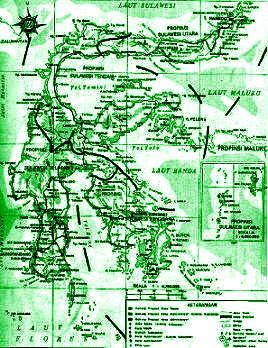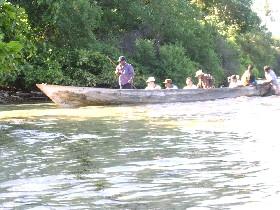| Sulawesi is particularly well endowed with lakes; it has 13 lakes that have an area greater than five km². It has the second and third largest lakes in Indonesia (Towutu and Poso). Most significant lakes have been surveyed in the last decade. These lakes are extremely diverse, ranging from the extremely shallow Lake Tempe (<1m deep in the dry season) to the beautiful Lake Matano, which at 590 m, is the deepest lake in South East Asia. These lakes occur at all altitudes and are found in each of the provinces. Most are formed by tectonic activity, but Lakes Tondano and Moat were formed by volcanic activity and Limbota and Tempe are flooded lakes. Aopa Swamp is the only large water body that is a swamp. Freshwater molluscs are among the better known of the macro invertebrates from the Sulawesi lakes. A total of 45 species of molluscs are known from Sulawesi lakes; 17 of these are from Lake Poso. Most molluscs are endemic species. Lake Poso has the most distinctive molluscs, including two endemic genera, both of which may now be extinct (Whitten et al 2002).
|

|
Little is known of the river systems, although the size and shape of Sulawesi precludes the development of long rivers, such as those found in Sumatra and Kalimantan; the longest is about 200 km. Most rivers are typically meandering channels, but the Palu River, several in Morowali and the Jeneberang River, for example, are braided (Metzner 1981). Many Sulawesi rivers arise in mountainous catchment areas but others arise in lakes, limestone caves and swamps.
Water birds are far more common than they are in the Sunda islands, probably because they are closer to the migratory pathways. Most species found on the lakes may also be found along the coast. The exception is the Australian Pelican (Pelecanus conspicillatus), which is more common on the lakes. At certain times of the year, Lake Tempe is a major lake for water birds (Uttley 1986).
Biodiversity Centers
The terrestrial biota of Sulawesi is unevenly distributed over the island. It tends to form groupings or biounits that relate in large part to the geological history of the island. Of the Sulwesi peninsulas, only the southwest Peninsula has flora that has its strongest affinities outside Sulawesi – and that is with Sundaland (van Steenis 1972). This may be due to some possible, but unconfirmed, land connection through the Nusa Tenggara islands of Flores or Sumbawa (Whitten et al. 2002). The allopatric distribution of closely related congenerics such as the Sulawesi Macaque, carpenter bees (Xylocopa spp.), Pond Skater/Water strider (Ptilonera) and white - eye birds (Zosterops spp.), support the view that the Sulawesi biounits are: the North Peninsula, Central Area, including Banggai Islands, Southeast Peninsula and the South Peninsula. Among the endemic birds, some species are known only from a specific peninsula. Half of the endemic species are known from all regions of Sulawesi and half have partially restricted distributions.
Whitten et al. (2002) draw attention to the uniqueness of the Malili Lake system in the southeast biounit. The entire system is connected by rivers and contains three large lakes (Matano, Mahalona and Towuti), and two smaller lakes (Masapi and Wawantoa). Of the 100 or so species of copepod, mollusc, prawn and fish endemic to Sulawesi found in this system, only a prawn and a goby fish are shared by all five lakes. This leads to speculation that the system is both an important repository of species and information about the origins of the Sulawesi freshwater fauna (Whitten et al. (2002).
The islands of Sangihe and Talaud are centers for endemic birds and butterflies. This island group also contains sites for endemic fishes and coral species and coral morphotypes due to the islands’ remoteness from other areas and the predominant oceanographic currents. They are one of the regions with the highest biodiversity relative to their area in Sulawesi and Indonesia.
The area in general from the southern boundary of Bunaken National Marine Park near Manado Bay along the northern coast of Sulawesi, and down the eastern coast to the southern tip of Lembeh Island is considered to be one of the two or three most diverse sites in the world for marine biota.
|
Bunaken National Park, is a classic small, integrated reef ecosystem, including mangroves, sea grass and coral in a wide variety of habitats (fringing reefs, lagoons, drop offs, pinnacles, etc.). It has an extraordinarily high level of marine biodiversity, close to matching and second only to the Raja Ampat area in Papua. Taka Bonerate National Marine Park, South Sulawesi, is the largest atoll in Indonesia. It is surrounded by more than 500 km² of corals and has a diverse reef fish community. Wakatobi National Marine Park, Southeast Sulawesi, has superb and representative coral reefs. It has approximately one hundred species of ornamental reef fish, many sea birds and Hawksbill, Loggerhead and Pacific Ridley Turtles.
Next >>> |
Source :
Report on Biodiversity and Tropical Forests in Indonesia.
Prepared by Steve Rhee, M.E.Sc.
Darrell Kitchener, Ph.D.
Tim Brown, Ph.D. Reed Merrill, M.Sc. Russ Dilts, Ph.D. Stacey Tighe, Ph.D. |
|




